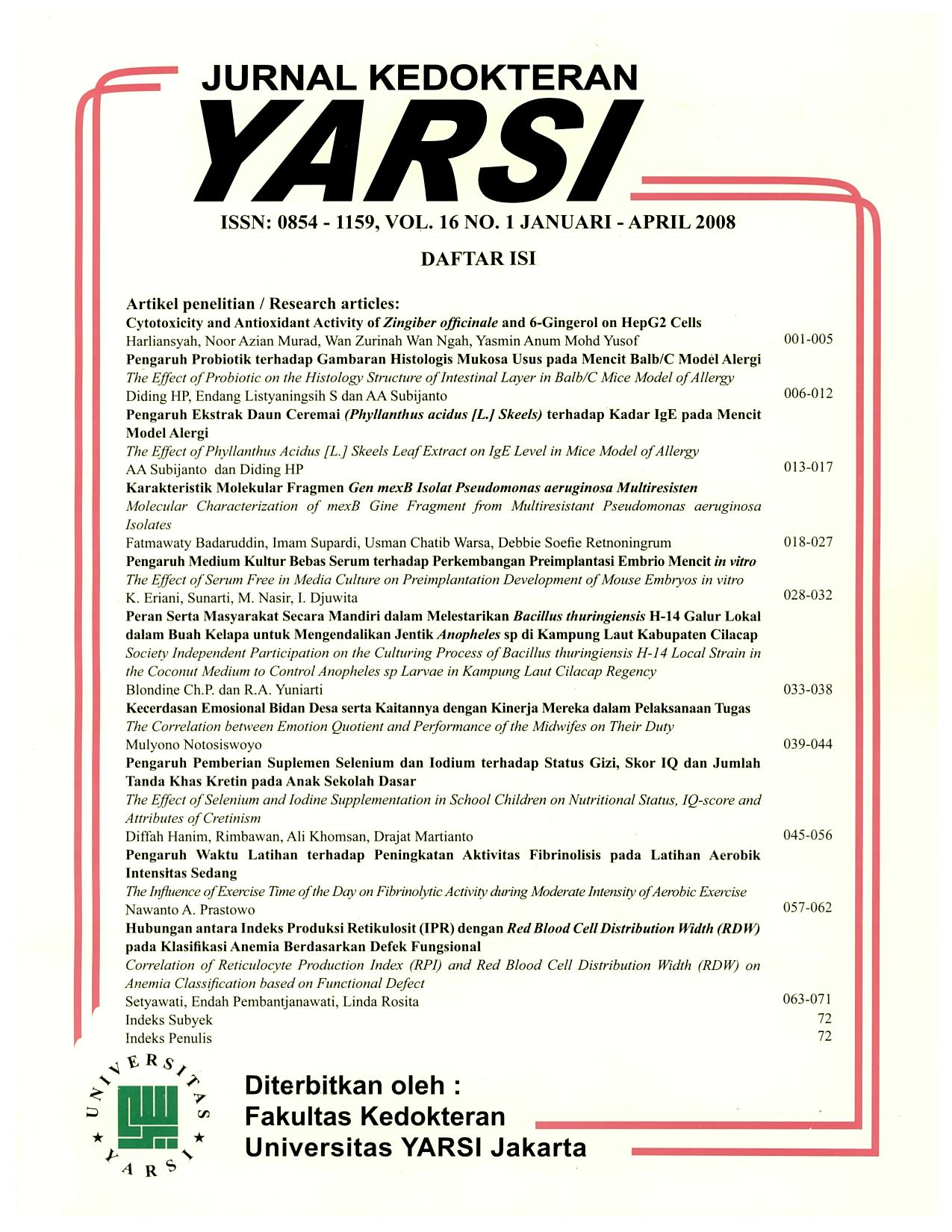Cytotoxicity and Antioxidant Activity of Zingiber officinale and 6-Gingerol on HepG2 cells
Keywords:
antioxidant, antiproliferation, [6]-Gingerol, HepG2, Zingiber officinaleAbstract
The present study was designed to compare the effects of ethanolic extract of ginger (Zingiber officinale) and its phenolic component [6]-Gingerol on viability, antiproliferation and apoptotic levels of human hepatoma cell lines (HepG2) and its antioxidant activity. HepG2 cells were cultured in Eagle’s minimum essential medium (EMEM) and the percentage of cell cytotoxicity was evaluated by tetrazolium salt (MTS) assay. Antiproliferation and apoptotic levels were measured by 5’Bromo-2’deoxyuridine (BrdU) colorimetry. Antioxidant capacity was studied by 1.1-diphenyl-2-picryl-hydrazyl radical (DPPH) using spectrophotometry. We found that cytotoxicity and antiproliferative effect of ginger extract and [6]-Gingerol could be associated with induction of apoptosis. The ginger ethanol extract and [6]-Gingerol also showed remarkable antioxidant activities in comparison with ascorbic acid and N-acetyl-L-cysteine.References
Aggarwal BB and Shishodia S 2006. Molecular targets of dietary agents for prevention and theraphy of ancer. Biochem. Pharmacol., 71: 1397-1421.
Bhattacharjee SK 2000. Ginger (Zingiber officinale). Handbook of aromatic plants, Pointer Publishers, India, pp: 473-474.
Chrubasik S, Pittler MH and Roufogalis BD 2005. Zingiberis rhizome: a comprehensive review on the ginger effect and efficacy profiles. Phytomed., 12: 684-701.
Farinati F, Cardin R, Fiorentino M, D’Errico A, Grigioni W and Cecchetto A 2001. Imbalance between cytoproliferation and apoptosis in hepatitis C virus related chronic liver disease. J. Viral Hepatitis., 8: 34-40.
Geiger JL 2005. The essential oil of ginger, Zingiber officinale, and anaesthesia. The Int. J. Aromathe., 15: 7-14.
Gosslau A and Chen KY 2004. Nutraceuticals, apoptosis and disease prevention. Nutr., 20: 95-102.
G?lcin I, Oktay M, K?frevio?lu OI and Aslan A 2002. Determination of antioxidant activity of lichen Cetraria islandica (L) Ach. J of Ethnopharmacol., 79: 325-329.
Ito M, Murakami K and Yoshino M 2005. Antioxidant action of eugenol compounds: role of metal ion in the inhibition of lipid peroxidation. Food Chem. Toxicol.,43:461- 466.
Lee J-Y, Hwang W-I and Lim S-T 2004. Antioxidant and anticancer activities of organic extracts from Platycodon grandiflorum A.de Candolle roots. J. Ethnopharm., 93: 409-415.
Liu H, Jin L, Tao S and Liu R 2002. Effect of Grape extract on HepG2 cell proliferation and apoptosis. Chin Med J. 115(3): 523-527.
Liu J, Hu W-X, He L-F, Ye M and Li Y 2004. Effects of lycorine on HL-60 cells via arresting cell cycle and inducing apoptosis. FEBS Lettr. 578: 245-250.
Paloza P, Serini S, Di Nicuolo F and Calviello G 2004. Modulation of apoptotic signaling by carotenoids in cancer cells. Arch Biochim Biophys. 430: 104-109.
Pang R, Tse E and Poon RTP 2006. Molecular pathways in hepatocellular carcinoma. Cancer Lettr., 240: 157-169.
Surh Y-J, Lee E and Lee JM 1998. Chemoprotective properties of some pungent ingredients present in red pepper and ginger. Mutation Res. 402: 259-267.
Surh Y-J 2002. Anti-tumor promoting potential of selected spice ingredients with antioxidative and anti-inflammatory activities: a short review. Food and Chem. Toxicol., 40: 10911097.
Taraphdar AK, Roy M and Bhattacharya RK 2001. Natural products as inducers of apoptosis: Implication for cancer therapy and prevention. Current Sci., 80(11): 1387-1396.
Tong X, Lin S, Fujii M and Hou D-X 2004. Molecular mechanisms of echinocystic acid-induced apoptosis in HepG2. Biochem. Biophys Res Comm. 321: 539-546.
Yamamoto Y, Nakajima M, Yamazaki H and Yokoi T 2001. Cytotoxicity and apoptosis produced by troglitazone in human hepatoma cells. Life Sci. 70: 471-482.
Yoo S-M, Oh S-H, Lee S-J, Lee B-W, Ko W-G, Moon C-K and Lee BH 2002. Inhibition of proliferation and induction of apoptosis by tetrandrine in HepG2. J of Ethnopharmacol. 81:225-229.
Young H-Y, Luo Y-L, Cheng H-Y, Hsieh W-C, Liao J-C and Peng W-H 2005. Analgesic and anti-inflammatory activities of (6)gingerol. J. Ethnopharmacol. 96:207-210.

 Harliansyah Hanif
Harliansyah Hanif
 Department of Biochemistry, YARSI University, School of Medicine, Jakarta Indonesia
Department of Biochemistry, Faculty of Medicine, Universiti Kebangsaan Malaysia, Jalan Raja Muda
Abdul Aziz, 50300 Kuala Lumpur, Malaysia
Department of Biochemistry, YARSI University, School of Medicine, Jakarta Indonesia
Department of Biochemistry, Faculty of Medicine, Universiti Kebangsaan Malaysia, Jalan Raja Muda
Abdul Aziz, 50300 Kuala Lumpur, Malaysia










